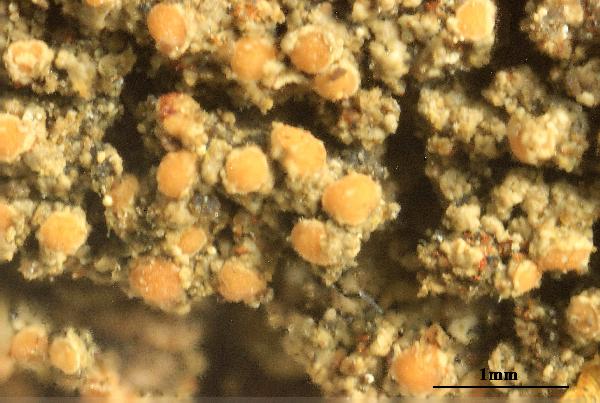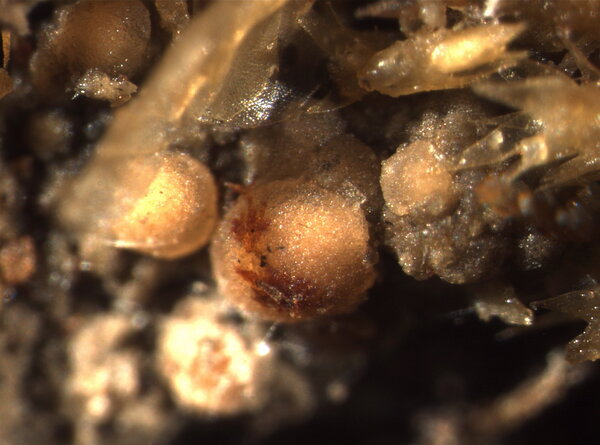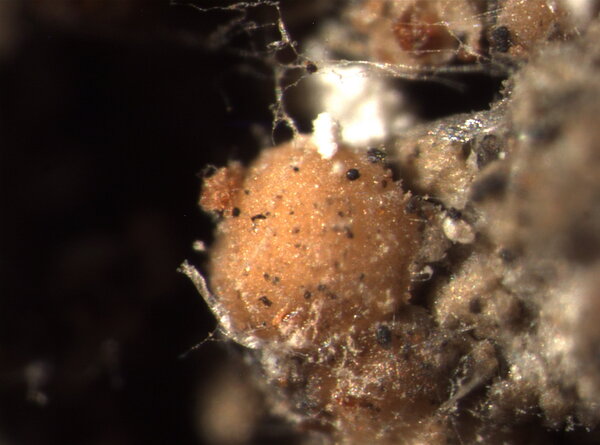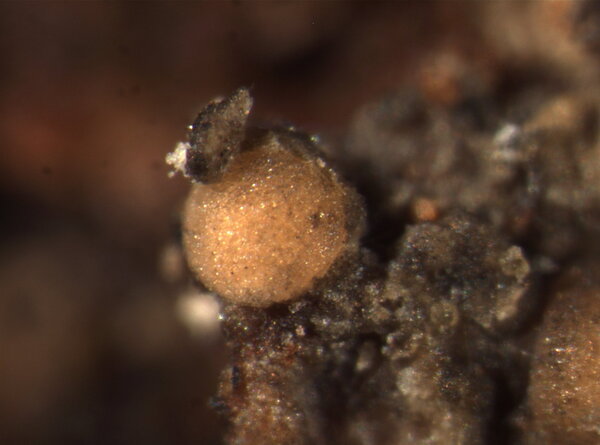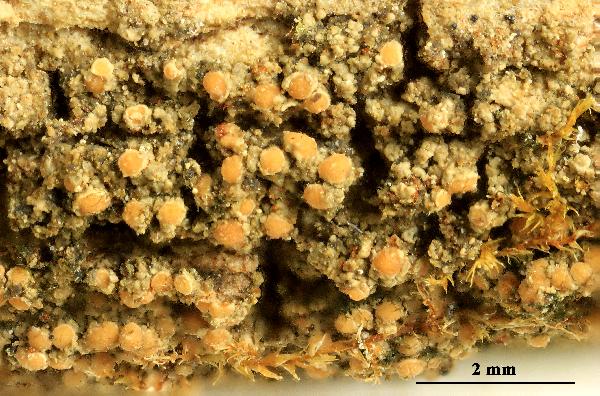Biatoridium monasteriense J. Lahm ex Körb.
Parerga Lichenol.: 172, 1860.
Synonyms: Biatorella elegans (A. Massal.) Stizenb.; Biatorella monasteriensis (“J. Lahm”) J. Lahm; Biatoridium elegans (A. Massal.) Reinke; Biatoridium monasteriense Körb.; Chiliospora elegans A. Massal.
Distribution: N - Frl (Tretiach & Carvalho 1993), Ven (Nascimbene 2008, Nascimbene & al. 2008e), Emil (Nimis & al. 1996, Fariselli & al. 2020). C - Tosc (Tretiach & Carvalho 1993), Marc (Candotto & Tretiach 2013), Umb (Ravera & al. 2006, 2006b), Laz (Munzi & al. 2007), Mol (Nimis & Tretiach 1999, Caporale & al. 2008), Sar (Rizzi & al. 2011, Di Nuzzo & al. 2022). S - Pugl (Nimis & Tretiach 1999), Si (Ravera & al. 2023b).
Description: Thallus crustose, episubstratic, pale grey-green when dry, becoming bright green when wet, effuse, continuous or minutely areolate, usually granular, poorly delimited, without a distinct prothallus. Apothecia biatorine, 0.2-0.5 µm across, partly immersed to sessile, yellowish, pale pink or pale dull red-brown, translucent and almost colourless when wet, with an initially flat but soon convex disc and a distinct, paler, thin, finally excluded proper margin. Proper exciple 15-25 μm thick, of structura globulosa, the hyphae hyaline and thin-walled, I-; epithecium pale red-brown; hymenium colourless or pale yellow, 60-85 μm high, I+ blue; paraphyses separating and clearly visible in K, mostly simple, c. 1.5 μm thick at base, the apical cells 4-6 μm wide; hypothecium colourless or pale yellowish brown, of intricately interwoven hyphae, (25-)40-85 μm high, I+ parchily blue. Asci 100-150(-200)-spored, narrowly clavate, thick-walled, especially at apex, with a layered apical K/I+ blue dome and a K/I+ intensely blue inner cap, the outer wall I+ pale blue, Biatoridium-type (Hafellner 1994). Ascospores 1-celled, hyaline, globose, 3-3.5 μm. Photobiont chlorococcoid. Spot tests: K-, C-, KC-, P-, UV-. Chemistry: without lichen substances.Note: a mild-temperate lichen found on deciduous trees with subacid (e.g. Quercus) to base-rich (Acer, Fraxinus, Sambucus) bark; much overlooked in the past, but locally not uncommon, especially in humid situations, e.g. along brooks.
Growth form: Crustose
Substrata: bark
Photobiont: green algae other than Trentepohlia
Reproductive strategy: mainly sexual
Most common in areas with a humid-warm climate (e.g. most of Tyrrenian Italy)
Commonnes-rarity: (info)
Alpine belt: absent
Subalpine belt: absent
Oromediterranean belt: absent
Montane belt: very rare
Submediterranean belt: extremely rare
Padanian area: absent
Humid submediterranean belt: rare
Humid mediterranean belt: extremely rare
Dry mediterranean belt: absent

Predictive model
Herbarium samples
Growth form: Crustose
Substrata: bark
Photobiont: green algae other than Trentepohlia
Reproductive strategy: mainly sexual
Most common in areas with a humid-warm climate (e.g. most of Tyrrenian Italy)
Commonnes-rarity: (info)
Alpine belt: absent
Subalpine belt: absent
Oromediterranean belt: absent
Montane belt: very rare
Submediterranean belt: extremely rare
Padanian area: absent
Humid submediterranean belt: rare
Humid mediterranean belt: extremely rare
Dry mediterranean belt: absent

Predictive model
| Herbarium samples |
 INDEX FUNGORUM
INDEX FUNGORUM
 GBIF
GBIF
 DOLICHENS
DOLICHENS
